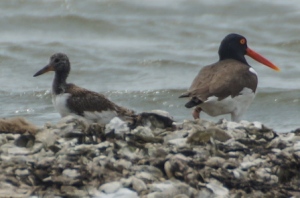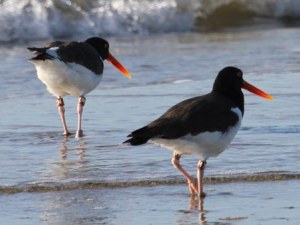By Susan Heath
Big News! We caught Fred (I’ll explain later) AND we banded our first chicks!
This week was a little windy, especially Thursday, but I was able to make it out to all the field sites on the appointed days without having to reschedule anything so that is definitely a win. On Monday, Alan Wilde and I were joined by Debi Shelton, another Galveston Bay Area Master Naturalist. It has been so great to make so many new friends who care about our Texas oystercatchers through the Master Naturalist program. I am really enjoying their company and their help. We were able to check all the pairs and found four new nests, two of which are re-nests from pairs that have already failed and are trying again. Five new nests hatched and we were able to get a glimpse of chicks at four of them. The other pair was definitely acting like they had chicks so we recorded it as a hatch. One nest failed for reasons we couldn’t determine. There wasn’t an overwash event and though there are Laughing Gulls in the area, that pair has a lot of experience fending them off so I’d be surprised if that was the culprit. That particular pair has had their nest predated by a rattlesnake twice so that might be the cause of the failure but we will never know for sure. One other pair wasn’t incubating anymore but we couldn’t tell if they had chicks. One of them was up by where the nest was so I thought it could have been guarding chicks but my gut instinct based on the behavior tells me that it was working on a new scrape. Alan got some good photos of J6 & P4’s chick which is the oldest one in West Galveston Bay at this point. This teenager is rather cute and we will be banding it on our next outing on April 20. This family had somehow managed to move to a neighboring island which is much lower than their nesting island. They must have walked over at a super low tide or the chick swam there for some reason. I hope we don’t get any high tides in the next few weeks or this chick could be in trouble.
The other big news from Monday is that we caught Fred. Who is Fred? Well, that is a good story. Lynn and John Wright live on Tiki Island and they can see one of the oystercatcher nesting islands from their deck so they’ve become rather attached to the pair of birds that nests there. They decided to name them Fred and Ethel since they weren’t banded and then they named the island Mertzville. We’ve had a great time joking about the goings on in Mertzville lately. Fred and Ethel have a nest so we decided to try to trap one. We tried to catch one of them this way last year and were not successful so I didn’t have high hopes but I decided to try anyway. We set the box up and moved off to watch from the boat. The incubating bird milled about for a bit and after about 10 minutes went in the box and started incubating the “eggs” (I replace the real eggs with fake ones in to keep the real eggs safe). The box has a string attached to the back that runs to the front where it is attached to the bottom portion of a split pin. You position the box so the string runs across the top of the eggs and when the bird lays down to incubate, it disturbs the string which disturbs the pin, and the box falls down trapping the bird. In this case the bird managed to get in and lay down without disturbing the string so the box didn’t fall.
That has happened a couple of times of before and we can usually rectify the situation by approaching slowly in the boat. When the bird stands up to walk away from the nest at our approach, it trips the box and that is what happened in this case. When I took the bird out, I knew immediately it was the male because of its small size (females are bigger than males). We banded him with the color bands FR that I had pulled out of my stock in case we caught him. I had saved out EH for Ethel if we caught her. I’ll have to save those for a future date though. Fred was a feisty little guy and didn’t have any trouble telling us what he thought about us catching him while we was trying to attend to his fatherly duties. I’m fairly sure there were some oystercatcher curse words uttered during the process. We got him banded and let him go in about 10 minutes so he wasn’t away from his nest too long. In case you’re worried about the nest – I’ve now trapped 30 birds this way and none have ever abandoned their nest. As soon as we take the box away they go right back. Here’s a photo of Debi holding Fred.
On Wednesday I was joined by John O’Connell a Cradle of Texas Master Naturalist and the Brazoria County Texas A&M AgriLife Coastal Marine Resources Agent and Sea Grant Agent. John wears a big hat! John, along with two other master naturalists, have offered to survey the oystercatchers during time periods when I am unable to get out there so he wanted to learn the ropes on our trip. In Drum Bay we found two new nests, one for K0 & unbanded and one for JK & unbanded. In both cases the unbanded bird was incubating so we tried to trap her, but in both cases we failed. Those are some smart girls! We also found XM, a 2013 chick from Drum Bay, hanging out in a territory that doesn’t have an adult pair this year. A month ago, I saw XM getting into it in Bastrop Bay with one of the adult pairs there, and then about 10 days ago I saw him on the beach on Follett’s Island hanging out with XH another 2013 chick (also from Drum Bay).
This time he was alone but he is clearly scoping out a territory for himself. He won’t be old enough to breed until next year but I guess he’s getting a jump on things. We also discovered that one of the banded birds appears to have disappeared. Where I expected to find E0 & unbanded, there was an unbanded pair. I’m pretty sure E0 was there the last time we were out (3/25/15) but I’m not positive. On that last trip, there was a pair of birds there with one banded, one not banded but I didn’t actually read the color band so while it’s likely it was her, I don’t know for sure. At any rate, she appears to have been replaced by an unbanded bird. Unless she turns up somewhere else, we won’t ever know what happened to her. Up in Bastrop Bay, we found two new nests so all the pairs up there have nests now. One of the nests from last time was missing an egg and I have no idea what happened to it. It doesn’t appear to have hatched and there aren’t many gulls there. These are the mysteries to oystercatcher reproduction for which we have no answers!
On Thursday I was joined by USFWS biologist Jennifer Wilson and TNC coastal rep Julie Sullivan to check on the birds in East Matagorda Bay. Most of the birds out there either have nests or chicks and one pair has three chicks that needed to be banded as they will be able to fly by the time we go out again. When we arrived we found they still had three chicks, so we did a bit of strategizing about how to catch them. Catching chicks can be a really tricky business. If they are on an island with a lot of cover they will hide and then it’s just a matter of finding them, but if they are on a small island without much vegetation like these were, they will swim to get away and believe it or not, they can dive like a duck to avoid getting caught. It is a great defensive mechanism for a chick that can’t fly yet but it makes it really difficult to catch them sometimes. The goal is to grab them or snatch them up in a dip net before they get out in the water. We managed to catch two of them but the third one was having none of our shenanigans and every time we approached the island to try to catch it, it would jump in the water before we could even get off the boat. After three tries, we gave up as I didn’t want to stress it anymore. That one will just have to go unbanded! Perhaps we should call it Michael Phelps. We banded the other two YP and YR. In all the commotion with trying to catch the third one, I forgot to take photos of the two we did catch. Oops! In the process of catching the two, I slipped and fell on the oyster shells too. Those shells are sharp!
After we were done with that, we checked on all the other pairs. We discovered another pair has three chicks too. It will be highly unusual if both these pairs in East Matagorda Bay fledge three chicks as we’ve only had one pair fledge three chicks each year. It’s all a matter of how much food is available. It takes a lot of work on the part of the parents to feed three chicks so usually all three don’t make it. We also found three pairs with two chicks and one pair with one. If we don’t get any major weather events in the next month, oystercatcher productivity in East Matagorda Bay is going to be very high this year. Yeah! We also trapped another adult on a new nest we found. It was a male again and we banded him EF. There are still two pairs incubating eggs and one pair hasn’t laid a nest yet. It was an eventful day but I was glad when we were done! It’s been a long week but of course I’m looking forward to getting back out there and checking on everyone again week after next.
Current Stats: 27 nests being incubated, 10 failed nests, 16 nests with unfledged chicks, 1 nest with undetermined status, 0 chicks fledged
We didn’t have any new adopters this week but now we have two chicks that can be adopted so if you’ve been waiting for a chick, now’s your chance! There will be chicks from West Galveston Bay to adopt after the next time I head out there too and you can still adopt a single adult or a pair of adults too. Adopt-an-oystercatcher here.
If you just want to donate you can do that through our Just Give portal.
Filed under: Birding
![]()






